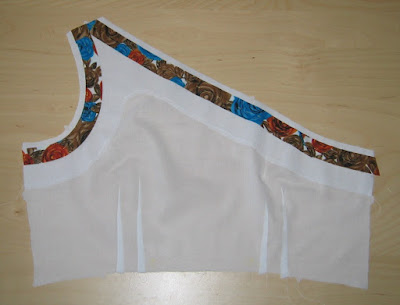 |
| The perfect fabric for a 1960 pattern |
I saw this fabric in a shop in Goldhawk Road, and knew straight away that it would be perfect for a late fifties/early sixties dress like the full-skirted version of Butterick 6582. Unfortunately I had no idea how much fabric the pattern needed, so I bought three metres, and hoped for the best.
My size actually requires 3.5 metres, but I was confident that with careful cutting out from a single layer of cloth - more work, but always an impressive fabric-saver - I could make it work.
Then I discovered that the fabric was actually 103cm / 40½" wide, not the usual 115cm / 45". Very strange (not quite the words I used when I made this discovery).
There was no way I could eke this out to cut the entire dress. Also, it's another very fine cotton, and I was worried that facings would show through. So I decided to miss out the facings altogether and line the bodice in white voile. As with the Blackbird Dress I wanted to make sure that the white wouldn't show at the edges. Unlike the Blackbird Dress, I didn't have enough fabric to cut even super-narrow facings, so I used bias strips instead.
Unusually, the skirt is cut side out sideways rather than lengthways. Fortunately the rose design is busy enough that this won't be obvious.
 |
| Cutting layout. Note the word 'sew-in' interfacing |
I made the skirt a little narrower, and managed to cut out everything I needed. There was even enough spare for two pocket backs.
 |
| Showing the bodice shape |
The bodice construction is unlike anything I've come across before. First, you make up the left front section. The shoulder is gathered, and the front is sewn to the facing along the full length of the front, and the bottom part of the armhole. Then the piece is turned right way out.
 |
| The armhole is stitched up to the green arrow |
The left front is then basted onto the main front.
 |
| Ready to baste together |
The facing is attached next, which should encase the raw edge of the seam across the front. The facing is much shorter than the bodice front, and narrower at the right shoulder because it isn't gathered. I had to frankenpattern my front lining out of the the facing and bodice front pieces. I then decided that iron-on interfacing would work much better than sew-in with the full length lining. I also spent ages carefully shaping the bias strips around the neckline and armhole, and basting them into place.
 |
| Can you tell what has gone wrong here? |
This was when I discovered that, it being August, my brain had decided to go on holiday without me. I had diligently constructed the lining the wrong way round, and because I had used iron-on interfacing I couldn't simply unpick it. Gah.
So, I made lining number two. Turns out that my frankenpatterning was a bit off, and it's a slightly too short in the centre. Fortunately I just happen to have a spare lining piece, so I can add a strip from that to pad it out!
 |
| Close, but not quite right |
 |
| The completed front section |
The backs are made the same way, and because they are symmetrical, even with my brain away sunning itself on a beach somewhere I couldn't go wrong.
 |
| Back section, front and lining |
Now comes the clever bit. You open out the shoulder section of the front and back, and sew them together. Right across the main dress and the lining.
 |
| Shoulder seam sewn together |
Then you fold in the raw edges, and slip stitch the remaining section of the armhole.
 |
| With the armhole finished |
Sew up the side seams, again sewing the dress and the lining in one continuous line of stitching. And then you have a beautifully neat bodice.
 |
| Bodice complete |

I've made this before! I made the full skirt version. Looking forward to seeing your completed dress!
ReplyDeleteLaurie
Thank you Laurie! Hopefully all will be revealed next week.
DeleteOh yes, that fabric is so late 50s/early 60s and just perfect for this dress! I'm always guessing at how much fabric I need for things but generally add on about half a metre extra just to be sure. I know I can always use any left over bits for something else. I do love all your work arounds though, there's some clever thinking there.
ReplyDeleteI've just bought an original 1930s dress pattern that has a very similar style of bodice, although it has sleeves and a decorative drape on one side. Having read the instructions it looks fairly simple but you never know until you actually start it. xx
I definitely need to apply your 'half a metre extra' rule in future!
Delete